| Title | Pages |
|---|---|
| Sol-Gel Synthesis And Characterization Of New Inorganic Pigments Containing Oxides of Iron, Aluminum, Strontium and Silicate Aseries of inorganic pigments containing iron, aluminum, strontium, and silicate were prepared by the sol-gel method using compounds with different structures and morphologies as starting materials. The synthesis of the compounds was carried out using the modified citrate method. All powders were placed in a muffle furnace and calcined in air at 1100°C for 6 hours. Powder samples containing Fe, Sr, Al and Si oxides were obtained. The structure and chemical composition of the synthesized five inorganic pigments were investigated comparatively by Fourier transform infrared spectroscopy (FTIR), UV-visible spectroscopy (UV-vis), X-ray diffraction (XRD), scanning electron microscopy (SEM), and Energy Distribution X-ray Analysis (EDX).
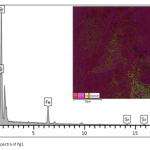 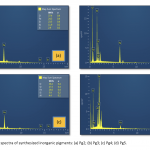 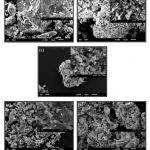 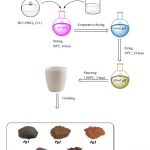 | 185 - 200 |
| Uromyces euphorbiae Cooke & Peck, A New Rust Fungi (Pucciniales) Record for Turkey. Arust fungi species, Uromyces euphorbiae Cooke & Peck (Pucciniaceae) on Euphorbia cheiradenia Boiss. & Hohen. (Euphorbiaceae) is reported for the first time from Malatya for Turkey and also on E. cheiradenia Boiss. & Hohen. (Euphorbiaceae) is reported as a new host species for the U. euphorbiae rust fungi. The morphological and microscopical features of this fungi are described with figures. 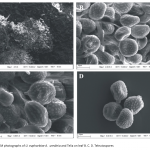 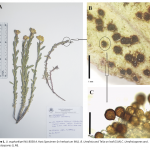 | 201 - 205 |
| Effects of Asymmetric Nanopore Geometries on Nanoparticle Sensing Using Track-Etched Nanopore Membranes Resistive pulse sensing, based on the Coulter Counter principle, is an important assay for sensing and separation processes to detect/discriminate several types of particles in various mediums. In such a set-up, attaining the signal from the smaller particles can be hard compared to larger particles. In this work, we focus on the critical role of pore shape on signal precision. We have simulated hourglass and cigar shaped nanopores to study the sensitivity for small particles. We have considered the translocation of 120 nm diameter particle by altering the surface charge as -0.001 C/m2, -0.007 C/m2 and -0.015 C/m2 under the applied potential between -0.3 V and -1 V with 0.1 increments. We have compared the signals in different concentration for identical-sized particles with varying surface charges. Comparison of pulse magnitudes and normalized current changes obtained from each pore shapes have shown that the cigar shaped pore yields more prominent signals for smaller sized particles than the hourglass pore. The results reveal that the hourglass shaped pore provides higher sensitivity than cigar shaped to discriminate the smaller particles and the hourglass pore might be preferable for nanopore sensor applications. 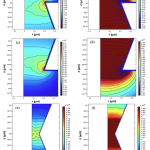 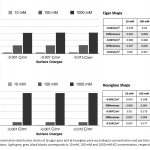 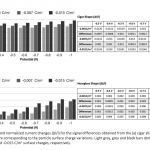 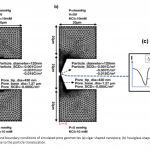 | 207 - 217 |
| Cloning, Over-Expression, and Purification of β–Carbonic Anhydrase from an Extremophilic Bacterium: Deinococcus radiodurans In this study, the cloning, purification and initial characterization of carbonic anhydrase (DrCA) enzyme which we consider to be important in the resistance physiology from extremely radioresistant bacteria Deinococcus radiodurans is performed. In addition, the effect of increased gamma irradiation doses on pH-related DrCA enzyme activity was determined. DrCA activity after radiation treatment showed that the activity continuously increased by 6 fold, up to the first 800 Gy, which a decrease in activity was observed thereafter. The maximum CO2 hydration activity for DrCA enzyme was observed at pH 7.0 and 40°C. DrCA enzyme, homo-dimer complex, is slightly thermostable. The activity of DrCA was significantly enhanced by several metal ions, especially Zn2+, which resulted in 5-fold increases of CO2 hydration activity. Also sulfonamide showed inhibitory effect on the pure enzyme. The apparent Km and Vmax for CO2 as substrate were 8.4 mM and 637 WAU/ mg for DrCA respectively. The CO2 hydration assay demonstrated that the specific activity of purified recombinant enzymes (DrCA) was significantly high. 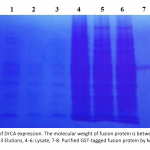 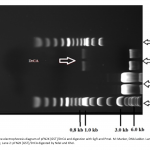 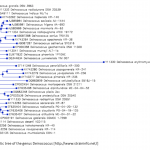 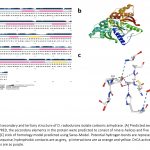 | 219 - 231 |
| Bioactive Compound Activity Inducement of Thermophile Cyanobacterium aponinum Under Stress Conditions In this report, bioactive properties of 7 thermophile cyanobacteria isolated from thermal springs in Turkey were investigated. Of these, Strain H2 having the highest antimicrobial activity was identified as Cyanobacterium aponium. Bioactive character of cyanobacterial biomass was investigated with regards to different nitrogen concentrations (0.5 g/L, 1.0 g/L, 1.5 g/L, and 2.0 g/L), light intensities (1200lx, 2400 lx, 3600 lx, and 4800 lx), incubation periods (7 d, 14 d, 21 d, and 28 d), and temperatures (30°C, 40°C, 45°C, and 50°C). It was observed that the effectiveness of bioactive substances produced by cyanobacteria was induced by stress conditions. When C. aponinum was exposed to high light intensity or temperature, cyanobacteria produced more efficient bioactive compounds then other environmental conditions tested. The highest antimicrobial activity was found against E. coli 0157:H7 ATCC 35150 with biomass extracts obtained when cyanobacterium cultivated in media with 1.0 g/L nitrogen, at 45°C, under 3600 lx illumination after incubation for 14 days. For the first time with such an approach as in the current study, production of bioactive compounds by a thermophilic C. aponinum and optimization of the environmental conditions to obtain the most efficient biologically active compounds was investigated. 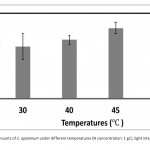 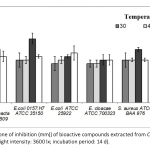 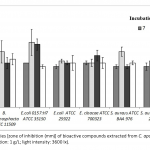 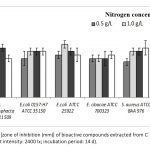 | 233 - 242 |
| Biodistribution of Whey Protein Labeled with Tc-99m on Experimental Animals In this study, whey protein was radiolabeled with Tc-99m using the SnCl2 reduction method. The paper electrophoresis technique was done in the radiochromatography studies. SF (saline solution) was used as a suitable mobile phase. At the same time, the labeling yield of 99mTc-WHEY was found to be about 95%. Then, lipophilicity and stability studies were carried out, respectively. Finally, imaging and biodistribution studies were completed using Albino Wistar Rats. In vivo studies showed that 99mTc-WHEY was accumulated in the breast, the ovaria and the pancreas. In conclusion, all results showed that 99mTc-WHEY may be helpful in the diagnosis of the breast, the ovaria and the pancreas in the future. 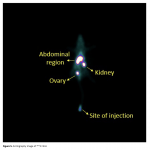 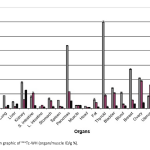 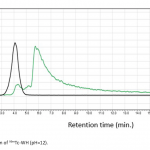 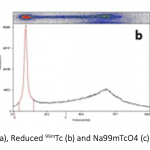 | 243 - 252 |
| Chiral Separations by Capillary Electrophoresis and Related Techniques with Different Chiral Selectors: A Review Recognition mechanism and enantiomerically separations of the chiral compounds are subjects that always stimulate the great interest of researchers in pharmacology and natural sciences, who are interested in finding solutions for both analytical purity and preparative purposes. Capillary Electrophoresis has become one of the most important analytical approaches for enantiomeric separations due to its superior properties, such as high resolution and high efficiency of chiral selectors. In this field, where researchers continue to be interested, the distinctions continue to develop day by day, with the introduction of new techniques developed on the basis of Capillary Electrophoresis philosophy in parallel with the development process of technology, as well as the chiral selectors of many different forms. In this review, besides some descriptive theoretical information about capillary electrophoresis and the techniques associated with it, studies on chiral separations using different chiral selectors or different chiral additives, such as molecularly imprinted polymers, cyclodextrins, Metal-organic frameworks, ionic liquids, nanoparticles and monoliths in the last nearly 10 years (2010-2020) were examined. 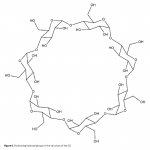 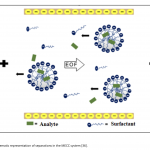 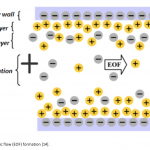 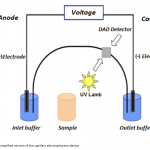 | 253 - 303 |
| DNAJC25 as a tumor suppressor candidate gene in breast cancer DNAJC25 gene is a member of the HSP40 (DNAJ) family, and it was suggested as a tumor suppressor gene in hepatocellular carcinoma. The aim of this study was to analyze the expression, genetic/epigenetic alterations, and prognostic value of the DNAJC25 gene in breast cancer. DNAJC25 transcript levels are upregulated in BT-20 and ZR-75-1 cell lines and downregulated in MDA-MB-231 cell line compared to the non-tumorigenic mammary epithelial cell line (MCF 10A) (P< 0.05). According to UALCAN in-silico tool, clinical breast cancer samples show significantly reduced levels of DNAJC25 mRNA relative to the normal samples (P=1.47e-02). The Kaplan–Meier plotter tool shows that high DNAJC25 expression is favorable for post-progression survival in breast cancer (P=0.0035). Point mutations or copy number variations of DNAJC25 areuncommon in clinical breast cancer samples. Combined bisulfite restriction analysis (COBRA) results showed that DNAJC25 promoter is not methylated in breast cell lines. Promoter hypomethylation was also observed in normal and tumor clinical samples (Beta-value<0.25). In conclusion, DNAJC25 is suggested as a tumor suppressor candidate having limited biomarker potential in breast cancer. Functional studies are essential to reveal its role in breast carcinogenesis. 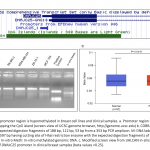 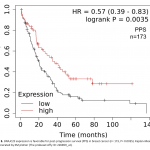 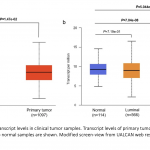 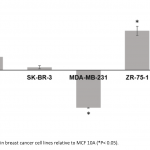
| 305 - 311 |
| Inhibitory Property of Poly (AN-co-VP) Copolymer on Some Dermatophyte Fungi and Yeasts Causing Fungal Infections Antimicrobial susceptibility test for poly (AN-co-VP) copolymer, which we think could be an ideal drug in treatment interventions was evaluated with disk diffusion method and minimum inhibitor concentration. In the antimicrobial measurement data, it was determined that the poly (AN-co-VP) copolymer dissolved in pure water is a significant inhibitory property against the growth of yeast (on Candida spp. with 11.33±0.3 mm barrier area) and dermatophyte fungi (on Epidermophyton sp. and Trichophyton sp. with 12.33±0.3 mm barrier area) (p<0.001) and no inhibitory properties were observed in preventing the growth of all bacteria (Escherichia coli, Pseudomonas aeruginosa, Klebsiella pneumoniae, Staphylococcus aureus, Bacillus megaterium). MIC limit values that prevent the growth of dermatophytes and yeasts supporting the disc diffusion method are 50-100 μL. This study is an alternative approach in order to limit the spread of superficial fungal infections they cause and eliminate these infections that tend to become chronic since this polymer extract has no inhibitory properties on bacteria but prevents the growth of yeast and dermatophytes. 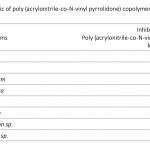 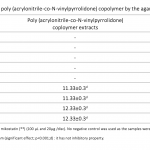 | 313 - 320 |
| A Forward Genetic Screen For Isolation Of Fusion Defective Mating Type Minus Mutants In Chlamydomonas reinhardtii Many biological processes require cell fusion, therefore defects in cell fusion result in many diseases. The unicellular green alga Chlamydomonas reinhardtii is an excellent model organism to study cell-cell fusion. The objective of this study was to identify genes that are involved in C. reinhardtii mating type minus (MT_) gamete fusion. A forward genetics approach was taken in our work. We created several MT_ fusion defective mutants using DNA insertional mutagenesis. These mutants were normal in the early stages of mating; they agglutinated with mating type plus (MT+), removed their walls, adhered to their mating partner through their mating structures, but the cells did not fuse, indicating that the DNA insertional mutants were defective in the latest stages of fusion. The number of insertions was confirmed by Southern blots. Mutant J1 had one insertion and the flanking genomic DNA was cloned by TAIL-PCR and RESDA-PCR. The insertion is in a gene predicted to be involved in 5-deoxystrigol biosynthesis. 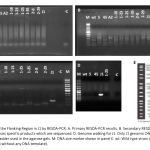 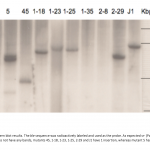 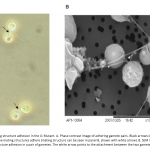 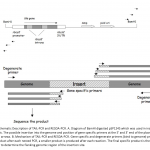 | 321 - 332 |